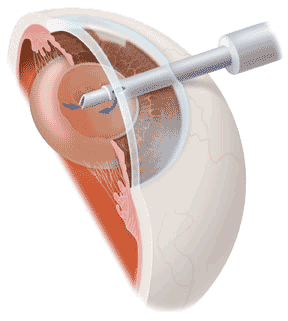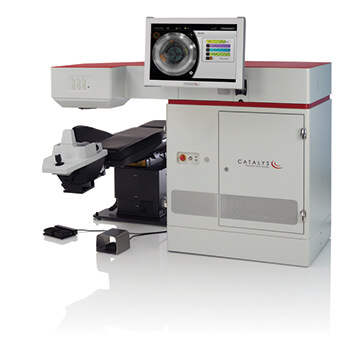Cataract Surgery
Phacoemulsification with intraocular lens implantation
Cataract surgery is one of the most successful operations performed around the world today. It is also one of the most common. A cataract is nothing more than the human lens that has become clouded as a result of age, medications, trauma, inflammation, or a variety of other causes. The approach to this problem is to remove the clouded lens and replace it with a clear, man-made, lens prosthesis called a lens implant. This implant serves to take the place of the lens that was removed.
Every attempt is made to place an implant with a power that will partially or completely incorporate any spectacle correction necessary. This leaves many patients with the ability to see without glasses when looking in the distance. Often reading glasses are necessary to help with near vision.
 Most cataract surgeries are performed with topical anesthetic and mild sedation, with no injections generally required. In the majority of cases the small incision makes it possible for the wound to seal itself without a stitch. Occasionally a suture is necessary to get a water tight seal. The lens can be removed through this small incision (about three sixteenths of an inch) because it is broken up and sucked out using an ultrasonic probe.
Most cataract surgeries are performed with topical anesthetic and mild sedation, with no injections generally required. In the majority of cases the small incision makes it possible for the wound to seal itself without a stitch. Occasionally a suture is necessary to get a water tight seal. The lens can be removed through this small incision (about three sixteenths of an inch) because it is broken up and sucked out using an ultrasonic probe.
The recovery period is two to three weeks. You may need to wear a patch for a few hours after the surgery. This can usually be removed on the afternoon or evening of the day of surgery. Usually vision is much better the next day, and better still within 2-3 days. Drops are prescribed for use before and after the surgery. These may be continued up to 4-5 weeks after surgery. You will be instructed not to touch, rub, or blot at the operative eye for at least one week, preferably longer. A shield will need to be worn when sleeping for one week, to prevent inadvertent rubbing. If it is necessary to do surgery on both eyes then the two eye surgeries can usually be done within one week of one another.
As with any surgery there are risks. The risk, however, is generally small–with fewer than two percent of cases ending in a poor result–when compared with the expected benefit.
Laser Assisted Cataract Surgery
 Exciting advancements have been made in laser-assisted cataract surgery, such as the CATALYS femtosecond laser. This laser can make all the incisions required for cataract surgery without using a blade or needle. The laser is customized for each patient and is used for the correction of astigmatism to achieve better vision without glasses. The CATALYS laser makes cataract surgery easier with its ability to soften the cataract so less energy is required to remove it. Medicus Eye Group has one of only two CATALYS lasers installed in South Carolina, the other is at Medical University of South Carolina. If you are considering cataract surgery ask your physician if the CATALYS laser at Medicus Eye Group would benefit you.
Exciting advancements have been made in laser-assisted cataract surgery, such as the CATALYS femtosecond laser. This laser can make all the incisions required for cataract surgery without using a blade or needle. The laser is customized for each patient and is used for the correction of astigmatism to achieve better vision without glasses. The CATALYS laser makes cataract surgery easier with its ability to soften the cataract so less energy is required to remove it. Medicus Eye Group has one of only two CATALYS lasers installed in South Carolina, the other is at Medical University of South Carolina. If you are considering cataract surgery ask your physician if the CATALYS laser at Medicus Eye Group would benefit you.

